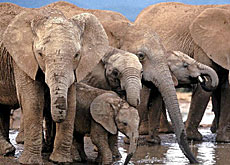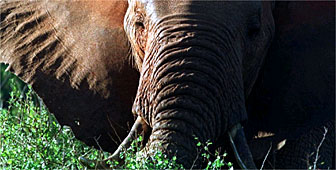Endangered species at risk from market forces

Representatives from 166 countries have gathered in Bangkok to decide whether to add more endangered species to a wildlife protection treaty.
But the Swiss delegation has warned that significant progress is unlikely as long as the trade in threatened plants and animals remains so profitable.
The signatory states to the United Nations Convention on International Trade in Endangered Species (CITES) meet every two to three years to vote on new additions to the list of protected animals, flora and fauna.
Fifty proposals are expected to be submitted during the two-week meeting, which wraps up on October 14.
CITES currently bans the global trade in 600 animal species and 300 types of plants, and strictly limits trade in more than 4,000 other animals and 28,000 plant varieties.
“The aim is to regulate legal trade and to ensure a sustainable use of natural resources,” said Thomas Althaus, director of the endangered species section at the Federal Veterinary Office and head of the Swiss delegation in Bangkok.
Althaus told swissinfo that the convention stipulated “objective scientific criteria” for determining whether a species should be added to the list.
“Some countries may make a political decision when voting, but what we don’t tend to see is trading between signatory states.”
Ivory ban
The convention, of which Switzerland is the depository state, came into force in 1975. It includes a ban on the trade in ivory and is credited with helping to save the African elephant from extinction.
But Althaus cautioned that the latest round of talks on the convention would not deter those who seek to profit from the trade in wildlife products.
“Take rhino horn, for example, which is big business in the Far East, and is used in particular in classical Chinese medicine. As long as it fetches high prices it is very difficult to control the trade,” he said.
Althaus added that one of the aims of the Swiss delegation would be to engage in constructive dialogue with the countries concerned.
“Switzerland is a small country and cannot do much on its own. But traditional Chinese medicine is an important topic, and [we will work with other countries] to convince those responsible of the need to avoid using endangered plants and animals and to look for substitute products.”
Richard Lehner, spokesman for the Swiss branch of environmental organisation WWF, said Switzerland had “an important role to play” within CITES.
“Though it can’t really influence decisions on the big issues involving animals like rhinos and elephants, Switzerland can take an active role in discussions on [regulating trade in other plants and animals] which pass through Europe.”
Enforcement
CITES senior enforcement officer John Sellar said one of the major priorities was to encourage the international community to adhere to both the spirit and letter of the convention.
“Wildlife crime remains a relatively low priority for most customs agents,” said Sellar.
“But depending on what you are smuggling, you can get more profits from wildlife than drugs,” he added.
The Swiss authorities say they are tackling the problem of identifying and seizing animals, plants and associated products which are on the CITES list by employing a team of experts to work with customs officials at border crossing points.
“When shipments arrive at our borders, we have to be able to identify them and see whether they are in accordance with the convention, so when we vote on whether to add new species to the list we always think about whether the treaty can be enforced in reality,” said Althaus.
“Customs officials are the first to see shipments, and if they think that a particular specimen is relevant to CITES, they call in the experts.”
Every year around 200 kilos of illegal items – mainly ivory – are discovered in passenger baggage by customs officials at Zurich airport.
swissinfo, Ramsey Zarifeh
Switzerland is the depository state of the Convention on International Trade in Endangered Species of Wild Fauna and Flora (CITES), which came into force in 1975.
Under the treaty, a ban was slapped on ivory trade in 1989 to help save the African elephant.
Today, CITES accords protection to more than 30,000 species of animals and plants.

In compliance with the JTI standards
More: SWI swissinfo.ch certified by the Journalism Trust Initiative


You can find an overview of ongoing debates with our journalists here . Please join us!
If you want to start a conversation about a topic raised in this article or want to report factual errors, email us at english@swissinfo.ch.